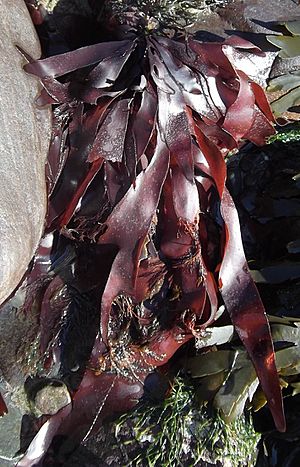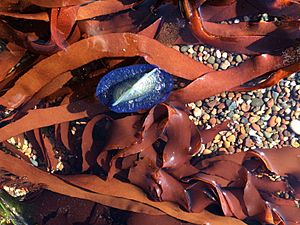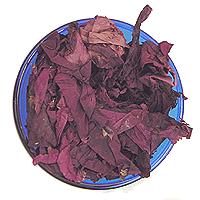Dulse facts for kids
Quick facts for kids Dulse |
|
|---|---|
 |
|
| Scientific classification | |
| Genus: |
Palmaria (alga)
|
| Species: |
palmata
|
| Synonyms | |
|
|
Palmaria palmata, also known as dulse, is a type of red seaweed. It's often called dillisk or dilsk (from Irish/Scottish Gaelic duileasc/duileasg). Other names include red dulse or sea lettuce flakes. This seaweed grows along the northern coasts of the Atlantic and Pacific Oceans. Dulse is a popular snack food. In Iceland, where it is known as söl, it has been an important source of dietary fiber for hundreds of years.
Contents
History of Dulse
The earliest known record of dulse comes from the island of Iona in Scotland. Christian monks there harvested this seaweed over 1,400 years ago.
What Does Dulse Look Like?
Dulse has a flat, leaf-like body called a frond. It attaches to rocks or other seaweeds using a small disc-shaped base called a holdfast. The fronds can be deep rose to reddish-purple in color. They feel a bit leathery.
These fronds can grow up to 50 centimetres (20 in) long. They are usually 3–8 cm (1.2–3.1 in) wide. Sometimes, smaller, wedge-shaped pieces grow from the edges of the main frond.
Dulse is similar to another seaweed called Dilsea carnosa. However, Dilsea is usually tougher and does not have branches growing from its edges.
How Dulse Grows
Dulse has a special way of growing and reproducing. There are male and female dulse plants, which grow separately. The larger plants are usually male or carry spores. The female plants are very tiny, less than 1 mm in size.
Spores, which are like tiny seeds, are found in patches on the mature dulse blades. Male plants produce special cells that fertilize the female plants. After fertilization, the tiny female plant grows into a larger dulse plant. This new plant then produces more spores, continuing the life cycle.
Where Dulse Lives
You can find P. palmata growing in the intertidal zone. This is the area between high tide and low tide. It can also grow deeper, up to 20 m or more underwater. Dulse lives on both sheltered and exposed coastlines.
Eating Dulse: A Healthy Snack
Dulse is often eaten as food and used in traditional medicine. It is popular in Ireland, Iceland, Atlantic Canada, and the Northeastern United States. You can find it in many health food stores or fish markets. Sometimes, it is even used as animal feed.
Dulse is very healthy! It's a good source of minerals and vitamins. It contains all the important trace elements humans need. Dulse also has a high protein content. It contains iodine, which helps prevent a condition called goitre.
People usually gather dulse from June to September when the tide is out. They pick it by hand. After picking, it's cleaned and spread out to dry in the sun. Once dry, it can be eaten as is, or ground into flakes or powder.
Fresh dulse can be eaten right off the rocks. Dried dulse is often eaten as a snack. When cooked, dulse can make food taste even better. In Iceland, people traditionally eat it with butter.
You can pan-fry dulse quickly to make crispy chips. It can also be baked with cheese or salsa. Dulse is great in soups, chowders, sandwiches, and salads. Some people add it to bread or pizza dough. If you chop it finely, it can even be used in meat dishes like chili to boost the flavor.
In Ireland, dulse is used to make "White Soda Bread." In Ballycastle, Northern Ireland, it's a traditional snack sold at the Ould Lammas Fair. It's very popular along the Causeway Coast. Many people still gather their own dulse there. Along the Ulster coastline, it's eaten dried and uncooked as a snack. On the west coast of Ireland, it's often called dillisk and sold by street vendors.

Scientists at Oregon State University have found a type of dulse (P. mollis) that grows very fast. They say this special dulse tastes like bacon when it's fried! It was first meant to be food for abalone farms.
Where Dulse is Found Around the World
P. palmata is the only type of Palmaria found on the Atlantic coast of Europe. You can find it from Portugal all the way to the Baltic coasts. It also grows near Iceland and the Faroe Islands.
Dulse is also found on the shores of Arctic Russia, Arctic Canada, Atlantic Canada, Alaska, Japan, and Korea. Some dulse found in California is actually a different species called Palmaria mollis.
Dulse and its Challenges
Sometimes, dulse plants can get small bumps or growths. These might be caused by tiny worms called nematodes, small sea creatures called copepods, or even bacteria. These growths are like small tissue bumps caused by the presence of these tiny organisms.
See also
 In Spanish: Alga dulse para niños
In Spanish: Alga dulse para niños


